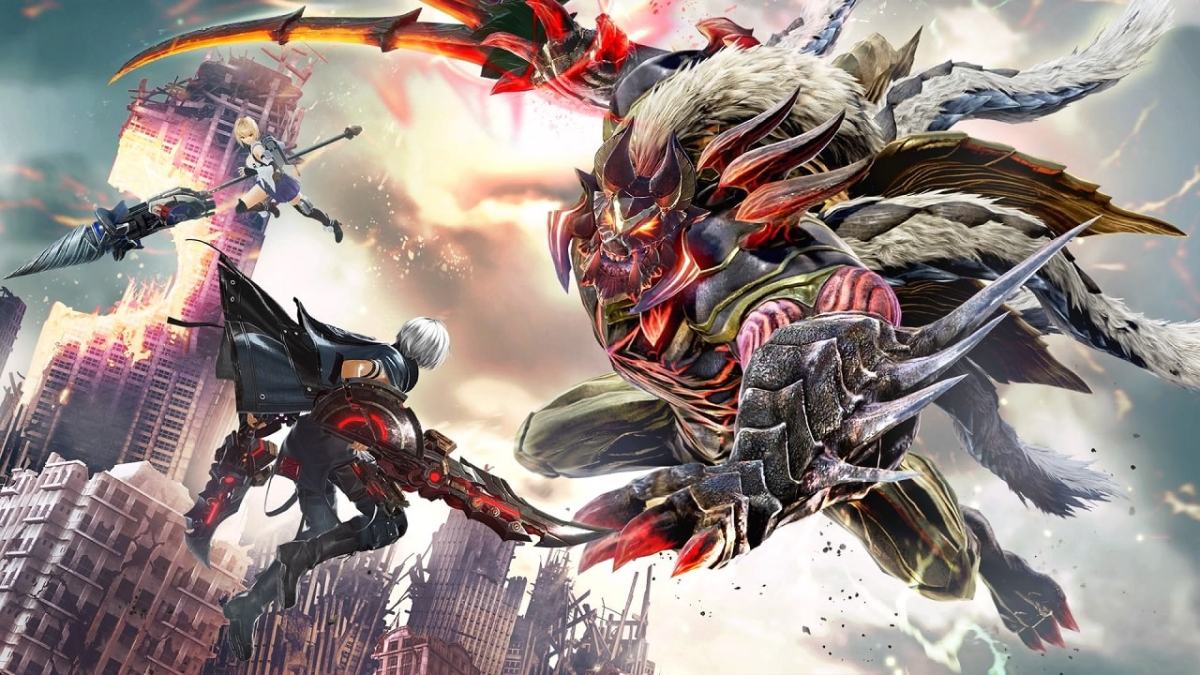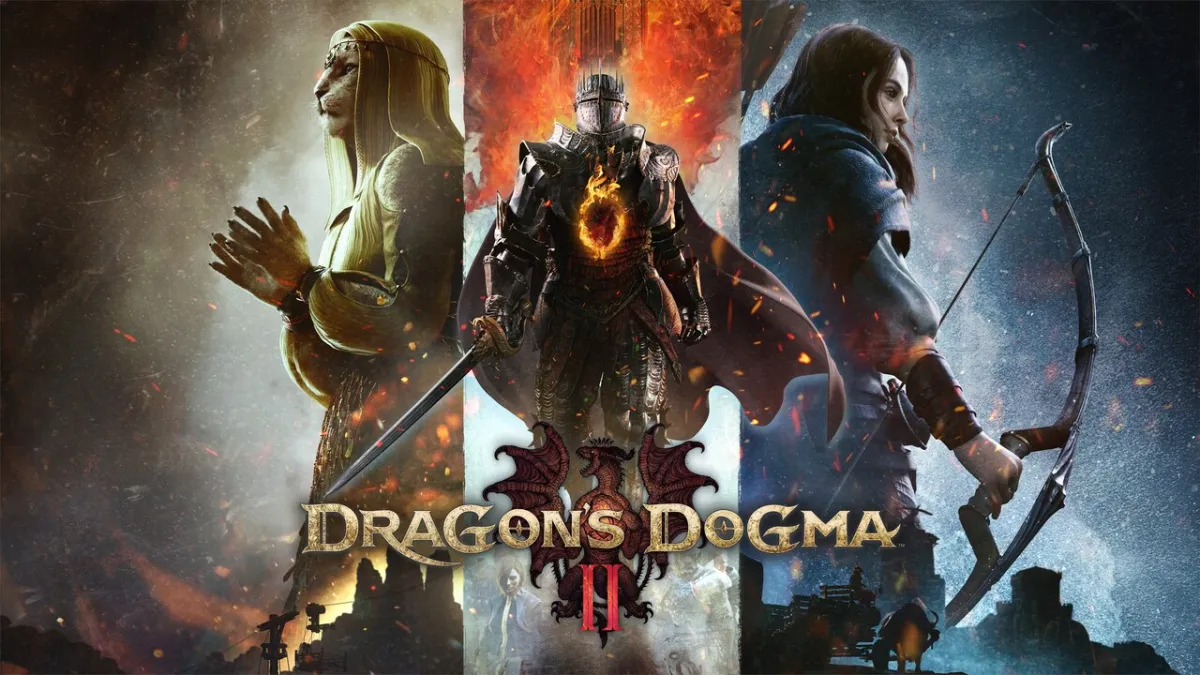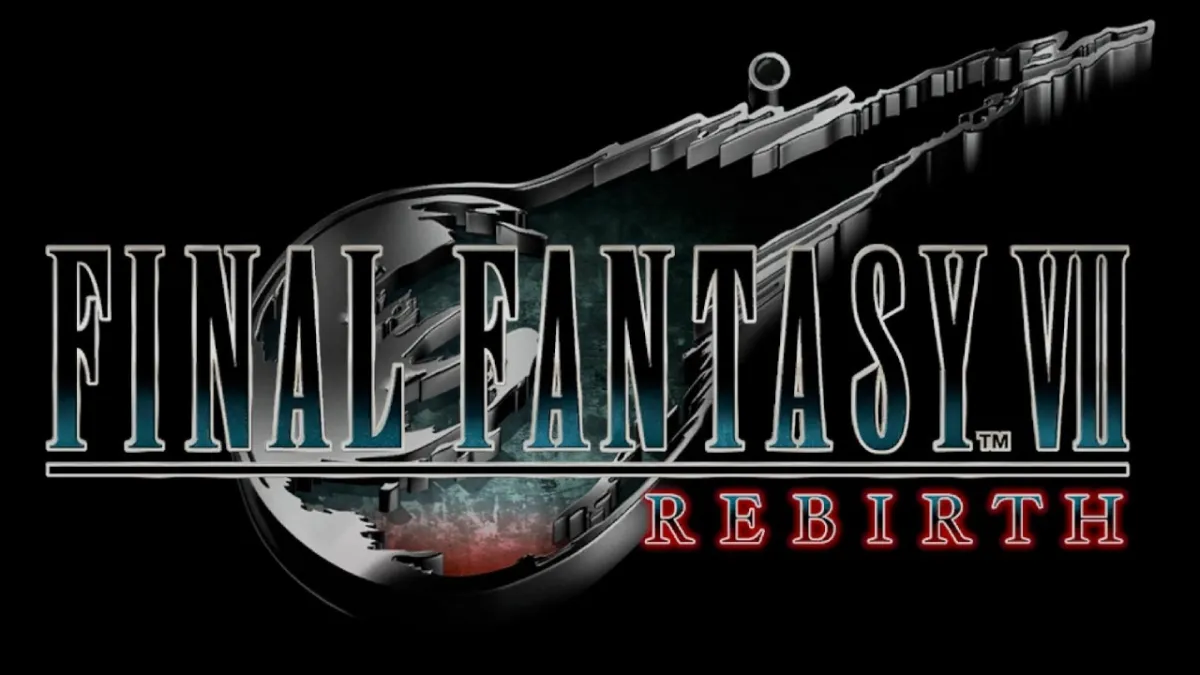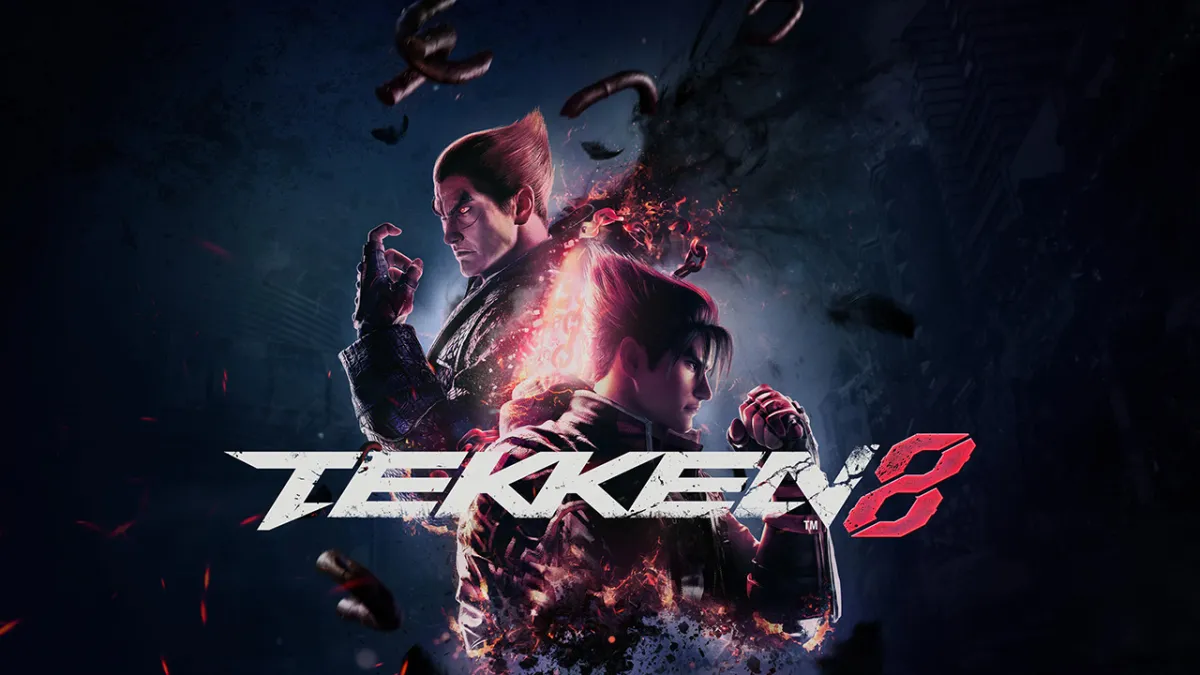I select my equipment, pick three allies and go out into the harsh wilderness to fight malevolent beings several times my size. Were this another time, such a scenario would be the stuff of fantasy. But in a world where humanity is on its last legs, this is a grim reality. Success on any given day just means I have to risk my life the next, while failure means humanity will be one step closer to annihilation.
This is the world of God Eater 3.
We’re presented with a world where modern civilization has collapsed. One where humanity is on its last legs and just barely holding on. Towns and cities that were once filled with people are now teeming with Aragami, monsters that live only to consume. And though humans once fought against this threat and even made some headway thanks to the work of God Eaters throughout the past two installments, that progress has been thoroughly undone following the arrival of the Ashlands, a phenomenon that turns everything it touches to ash. Humanity has now been forced to take refuge underground and form small communities where they created Adaptive God Eaters (AGE) who can resist the influence of the Ashlands and work to find some way to bring humanity out of its current predicament.

However, behind the story about humanity’s struggle for survival is a simpler story: you. You’re one of those AGEs and you’ve been one since you were forced into the role as a child. There are no dreams of exploring a new world — just surviving in the one you’re stuck in. All you have are your friends at your side, the clothes on your back, the weapon in your hands and a giant mobile fortress you call your home.
It’s an interesting premise, but not one that is fully realized. With Marvelous now behind the wheel (yes, that Marvelous) and a shift to the PS4 and PC, I expected something of a reboot similar, though not necessarily on the same scale, to what Capcom did with Monster Hunter: World.
Needless to say, that isn’t quite what happened.
It almost feels like I’m turning on my own fandom for comparing God Eater 3 to a series that’s caused it to suffer plenty of mischaracterizations such as “Monster Hunter but for noobs” or “anime Monster Hunter” due to both occupying the same subgenre, but I’m certain the comparisons will be inevitable following Monster Hunter: World’s entry into the mainstream, so I might as well steer into the proverbial skid.
But before moving on, I’ll just drop this nugget of knowledge: God Eater does not play like Monster Hunter. Trying to play it as such will only lead to disaster.

Yes, there are similarities, of course. Such ill-informed characterizations wouldn’t exist otherwise. You’re still fighting giant monsters and progression relies on you creating equipment from the corpses of said monsters in order to defeat even more of them, but the similarities end there. God Eater is an entirely different beast.
So like I stated before, God Eater 3‘s greatest weakness is that it doesn’t doesn’t do enough with it’s narrative. Specifically, it provides an interesting backdrop for humanity’s predicament, but doesn’t do much beyond that.
For instance, the game’s lore explains that due to the Ashlands forcing humans to move into underground communities, called Ports, AGEs are the ones who are now forced to do most of the work. And what does this work entail? Killing Aragami, mostly (no complaints about animal abuse here, folks!). My issue, however, is that there’s so much more the developers could have done here. Resources, despite reportedly being scare, are never actually brought up in the story. Untrodden routes house dangers that never make themselves apparent before you have the option of avoiding them. Why couldn’t there have been missions where you collect resources or perform reconnaissance? Maybe combine the two into a separate mode? There are more ways that the severity of the world could be conveyed to the player and doing so would have been an effective way to connect the gameplay with the narrative.
Fortunately, I can say that what it does do: provide a plethora of missions fighting Aragami, is an absolute treat.

Whereas combat in Monster Hunter: World is methodical, God Eater 3’s is fast-paced and chaotic. You aren’t waiting for your opponent to make a move, you’re actively making one — even several — yourself. And this is required because the Aragami are relentless and only stop attacking after it’s done a major attack, stunned from taking a certain amount of damage (or breaking a body part), or either your team or it is dead. Reflexes are the name of the game here and you’ll need to be quick on both offense and defense if you want to survive.
Adding on to that, this game is one that highly rewards those who are proactive. Devouring a boss by pressing or holding L1+Triangle (Predator Styles are gone, so you can only perform charge, quick, combo and air devours) activates Burst, a powered-up state which grants boosted stats, extra abilities (based on what you equipped beforehand), an aerial jump and an alteration of one of your ground, dash and aerial attacks called Burst Arts (replacing Blood Arts). Furthermore, staying near your allies in combat will allow you to activate Engage (L2+R2), granting a preset buff and sharing all active ones between bonded characters, while performing various maneuvers (Just Guards, restoring OP (the resource for your gun), devouring, etc.) will activate another preset buff called an Acceleration Trigger. Your goal? Ensure all these buffs remain active as long as possible for quicker clear times.
And you’ll certainly need to make sure your reflexes are on point and have your buffs active in order to take on the myriad of Aragami that now populate the earth. In particular, the Ashborn, a new type of Aragami born from the Ashlands, are particularly dangerous thanks to their ability to enter a Burst state of their own by “devouring” a player with a certain attack after they enrage. Not only does entering this state grant them a new set of attacks along with enhanced stats, but it means the person who got devoured will be inflicted with a new status effect called Corruption which will leave them weakened and unable to receive Link Aid (revive), Link Burst (Burst from another player) or Engage effects. Really, this alone should encourage anyone who is serious about playing God Eater 3 to learn how to Just Guard, as that is the most reliable way to stop an Ashborn dead in its tracks. Think about it like this: would you rather learn a technique that will help you in every encounter you come across or risk dealing with an enemy who not only attacks fast, but can now kill any member of your squad in one or two hits?
There likely won’t be any part of combat you won’t take a shining to. The weapons are as varied as the enemies you’ll be using them against, and the fast-paced combat means there will rarely be a dull moment during missions. If anything, the only thing I can imagine some players taking issue with is how you now have to put effort into gunplay. A new cost system limits how much custom ammo made through the Bullet Editor you’re allowed to bring into battle, and though I’m probably not the best person to ask on this subject, it doesn’t seem like the ammo you can create are as powerful as in previous entries. You’ll now need to aim properly in order to target an Aragami’s weak spots, and gear appropriately if you want to be considered a legitimate gunner.
As for me, my issue with the combat had nothing to do with the mechanics. Instead, it had everything to do with where all the combat takes place — the zones.

To put it mildly, the zones are disappointing. We know about the status of the world thanks to the lore, but it’s rarely reflected in the areas we visit. Knowing the differences between Bandai Namco and Capcom, I was by no means expecting something on the same scale as the zones in Monster Hunter: World (Coral Highlands is the most mesmerizing zone in the game, if not the whole series); however, surely a game that is ditching handhelds could do better than just a few rundown streets and a dilapidated church. There was real potential to see large, decaying cities that stood as a testament to the collapse of modern civilization, but all we got were zones that provided little in the way in the form of immersion and interaction beyond the small, shining white lights that are supposed to pass for gathering spots.
More than just the lack of immersion and interactivity, though, what truly irritated me was just how small most of the zones are. Like I said before, the Aragami are relentless in their attack and this means that both it and your team will be making a ton of noise when a fight breaks out. The problem? Some areas are so small that other Aragami can actually hear the fight, run over and then intervene on the other’s behalf. This isn’t an issue early on since you’ll only be fighting a single large Aragami in a relatively large zone, but later missions (starting at Rank 5 or so) will require you to tackle two or more larger Aragami — one of whom might even be an Ashborn — in a small space. Maybe more experienced players have a better solution, but I typically either use a stun grenade or command my allies to disperse in order to grab the attention of one Aragami while I kite the other away (this is particularly important for certain Aragami like Marduk who can cause others to enrage whenever it enrages).
And amusingly enough, my greatest gripe with God Eater 3 in general arose when the battle was actually over. Yes, I’m talking the loot system.

Remember how I mentioned that breaking a part of an Aragami’s body caused it to collapse for a few precious seconds? Well, if this were Monster Hunter that meant I would be privy to the associated reward. In this game, though? Nope! Every single reward you can earn is based on probability and the best ones usually have various conditions attached, such as completing a mission with at least six endurance remaining (you lose one when your character loses all their health and another two if you if you choose to respawn without being revived first). This means that fulfilling such conditions are only a prerequisite to getting the rewards you seek — there’s still the actual probability of it showing up to contend with. There were many times when I would break multiple parts of an Aragmi’s body, not die and beat the mission in under 10 minutes but still only get the standard rewards even with the bonus conferred by getting an SSS grade.
Needless to say, this whole system makes crafting new equipment quite the chore — even more so when said equipment requires you to fight an Ashborn. For reference, getting killed while inflicted with Corruption results in you automatically respawning, meaning that you can only die one more time before you fail the six endurance condition. See why I said learning to Just Guard is so important? In all honesty, this could have been mitigated somewhat if the items you could use to trade for various materials dropped more reliably, but those too are tied to a stipulation. Then again, it probably wouldn’t be much fun if you could get everything you wanted at the drop of a hat.
Beyond that, though, there isn’t much I can legitimately complain about. God Eater 3 succeeds where it needs to and its shortcomings doesn’t impact the overall package too severely. As someone who often plays games like God Eater, Monster Hunter, Freedom Wars, Soul Sacrifice, etc., I see no reason why these games can’t coexist — they’re different enough to do so. Though I do admit it wouldn’t have hurt for God Eater 3 to include more QoL options like World’s radial menu or just ways to test out other weapons and guns in the practice room without constantly needing to go the menu screen.
Lastly, I should mention the amount of content that will presumably be available on release.

My copy of God Eater 3 featured seven tiers of content, six of which were a mix of story and optional quests. It took me about 28 hours to complete the main story, so use my experience as an intermediate level player who likes to grind a bit as a benchmark for yourself.
There’s standard multiplayer missions and an eight-player Assault Mode that I haven’t touched yet (multiplayer didn’t seem to be enabled), so that combined with the post-game means that there should be plenty for anyone of any skill level to sink their teeth into.
More importantly, though, Bandai Namco announced during the Japanese launch event back in December that there are plans to release over 100 new missions in the future, as well as forgoing the previous Burst model in favor of multiple post-launch updates. There have been no details as to when they’re coming or what they’ll contain (I’m hoping for some actual character episodes, personally), but you can be sure the game will be very different compared to what we’ll have initially, so that’s definitely something to look forward to.

The Verdict
God Eater 3, much like Monster Hunter: World, has ditched its handheld roots and is now exclusive to the PlayStation 4 and PC. However, whereas the latter fully embraced its new home, the former has shortcomings that don’t use the transition to its advantage. The zones are still lacking in depth, and it’s in desperate need of QoL features that should be a standard in the subgenre.
That said, it still succeeds where it counts. There’s plenty of enemies to defeat and a wide array of weapons to do so with, all done at a pace this is simply exhilarating to participate in. If you liked the scent of Monster Hunter, but couldn’t stomach the execution, then God Eater 3 will likely be a meal you’ll be willing to devour.







